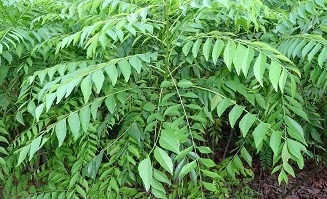Kurry plant is a tropical or sub-tropical plant. It taxonomically belongs to family Rutaceae. It is considered to be a native to Asia. Its taxonomic name is Murraya koenigii.
The generic name of the Kurry plant has been derived from the name of Johann Andreas Murraya who was a disciple of Linnaeus. He was a professor of medicine having interest in medicinal plants and studied medicinal plants in Germany.
Kurry is a small tree which grows from 4 to 6 m in height. Its leaves are aromatic. These are pinnate with 11 to 21 leaflets. The plant bears small white flowers. Flowers are usually self- pollinated and occasionally insect pollinated. Fruit is drupe which is shiny black in colour. Its pulp is edible.
This plant grows in well drained soils under full sunlight. Its commercial plantation is now done in India and Australia. The plant is propagated by seeds and stem cuttings. It can also be grown in pots.

Kurry leaves usually contain cinnamaldehyde and carbazole alkaloids. Mahanimbine, girinimbine alkaloids are also reported to be contained in its leaves, barks etc.
The meethi Neem or Kurry is most beneficial for health. It is full of medicinal values. The consumption of its leaves increases immunity. Fresh leaves are parts of Indian cuisine and traditional medicines. The extract of leaves if taken internally is anti-diabetic, anti-oxidant, antimicrobial, antihypercholesterelimic. The extract contains zinc, iron etc. It enhances insulin production in the body.
Benefits for diseases
-It contains iron, calcium and phosphorus,
-It contains vitamin B12, B2, B6, and B7,
-It helps in anemia, High Blood Pressure etc. diseases,
-It balances glucose in the blood,
-It clears digestive system and gives relief from constipation,
-Eating leaves of this plant reduces weight. It also controls cholesterol in blood.
Uses in Food Items
- Leaves of this plant are used in frying food items,
- Leaves are also used in poha,
- Its leaves are also used in making chutneys
Immunomodulatory Properties, Murraya koenigii , Kurry Plant




